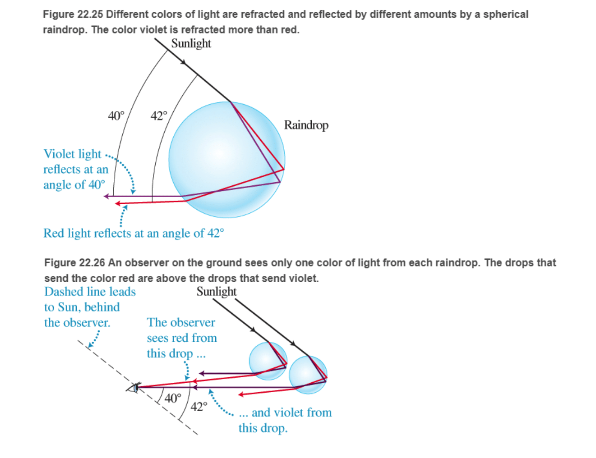
Concept explainers
Rainbows How is a rainbow formed? Recall that the index of refraction of a medium is slightly different for different colors. When white light from the Sun enters a spherical raindrop, as shown in Figure 22.25, the light is refracted, or bent. After reflecting off the back surface of the drop, the light is refracted again as it leaves the front surface.

Each drop separates the colors of light. An observer on the ground with her back to the Sun sees at most one color of light coming from a particular drop (see Figure 22.26). If the observer sees rod light from a drop (for example, the top drop in Figure 22.26), the violet light for that same drop is deflected above her head. However, if she sees violet light coming from a drop lower in the sky, the red light from that drop is deflected below her eyes onto the ground. She sees red light when her line of view makes an angle of

Why is violet light refracted more than red light?
a. The violet light travels a shorter distance in the drop than the red light.
b. The red light travels more slowly than the violet light.
c. The refractive index of water for violet light is greater than that for red light.
d. All of the above.
Want to see the full answer?
Check out a sample textbook solution
Chapter 22 Solutions
Pearson eText for College Physics: Explore and Apply -- Instant Access (Pearson+)
- Light in medium A undergoes a total internal reflection as it reaches the interface with medium B. Which of the following statements must be true (choose all that apply)? (a) nB nA (b) nB nA (c) All light rays that undergo a total internal reflection travel along the interface between the two materials. (d) Light traveling in the opposite direction, from B into A, cannot undergo a total internal reflection.arrow_forwardYou are working for a solar energy company. Your supervisor has asked you to investigate a new idea that has been proposed for a solar collector. A large sphere of glass focuses light on photocells, as shown in Figure P35.22. The photocells are moved by electronics along the curved track to the right of the sphere. Your supervisor would like to build a prototype of a material with index of refraction n, but needs for you to calculate the position at which the Suns rays focus and, therefore, to find where to locale the curved track. Figure P35.22arrow_forward14. A ray of light strikes the midpoint of one face of an equiangular (60°−60°−60°) glass prism (n = 1.5) at an angle of incidence of 30°. (a) Trace the path of the light ray through the glass and find the angles of incidence and refraction at each surface. (b) If a small fraction of light is also reflected at each surface, what are the angles of reflection at the surfaces?arrow_forward
- A ray of light is incident at an angle 30.0 on a plane slab of flint glass surrounded by water. (a) Find the refraction angle. (b) Suppose the index of refraction of the surrounding medium can be adjusted, but the incident angle of the light remains the same. As the index of refraction of the medium approaches that of the glass, what happens to the refraction angle? (c) What happens to the refraction angle when the mediums index of refraction exceeds that of the glass?arrow_forwardA laser beam is incident at an angle of 30.0 from the vertical onto a solution of corn syrup in water. The beam is refracted to 19.24 from the vertical. (a) What is the index of refraction of the corn syrup solution? Assume that the light is red, with vacuum wavelength 632.8 nm. Find its (b) wavelength, (c) frequency, and (d) speed in the solution.arrow_forwardUnreasonable results Suppose light travels from water to another substance, with an angle of incidence of 10.0and an angle of refraction of 14.9 . (a) What is the index of refraction of the other substance? (b) What is unreasonable about this result? (c) Which assumptions are unreasonable or inconsistent?arrow_forward
- Figure P35.8 shows a refracted light beam in linseed oil making an angle of = 20.0 with the normal line NN The index of refraction of linseed oil is 1.48. Determine the angles (a) and (b) '.arrow_forwardFigure P22.16 shows a light ray traveling in a slab of crown glass surrounded by air. The ray is incident on the right surface at an angle of 55 with the normal and then reflects from points A. B, and C. (a) At which of these points does part of the ray enter the air? (b) If the glass slab is surrounded by carbon disulfide, at which point does part of the ray enter the carbon disulfide?arrow_forwardExpress your understanding of filters by answering the following questions. Choose the best answer(s) from the Color Table. k. A blue object is illuminated with white light and viewed through a green filter. The object will appear _____. l. A cyan object is illuminated with white light and viewed through a cyan filter. The object will appear _____. m. A cyan object is illuminated with white light and viewed through a green filter. The object will appear _____. n. A yellow object is illuminated with white light and viewed through a green filter. The object will appear _____. o. A yellow object is illuminated with white light and viewed through a magenta filter. The object will appear _____. p. A yellow object is illuminated with yellow light and viewed through a yellow filter. The object will appear _____. q. A yellow object is illuminated with yellow light and viewed through a blue filter. The object will appear _____. r. A yellow object is illuminated with blue light and viewed…arrow_forward
- A beam of light is incident from air onto the flat surface of a piece of sapphire. Part of the beam is reflected and part is refracted. If the angle of refraction inside the sapphire is 33.5°, what is the angle of reflection for the rest of the beam? All angles are measured from the normal to the surface. Material Fluorite Fused Quartz Sapphire Diamond ... Index of Refraction 1.40 1.50 1.79 2.42 A 72.1° B 83.5° C) 17.9° 6.5°arrow_forwardA beam of white light is incident at 340 to the surface normal of a stagnant lake. When the light is transmitted into the water, the different colors of light will be refracted at different angles to the normal. Which color of light will be refracted at the smallest angle relative to the normal? a. Blue b. Red c. Orange d. Green e. Yellowarrow_forwardLight is incident on water at an angle of 45° from air. Use the data table in the formula sheet for reference to determine the index of refraction. Which equation would you use to calculate the angle of refraction? Calculate the angle of refraction inside water.arrow_forward
 Physics for Scientists and Engineers: Foundations...PhysicsISBN:9781133939146Author:Katz, Debora M.Publisher:Cengage Learning
Physics for Scientists and Engineers: Foundations...PhysicsISBN:9781133939146Author:Katz, Debora M.Publisher:Cengage Learning Principles of Physics: A Calculus-Based TextPhysicsISBN:9781133104261Author:Raymond A. Serway, John W. JewettPublisher:Cengage Learning
Principles of Physics: A Calculus-Based TextPhysicsISBN:9781133104261Author:Raymond A. Serway, John W. JewettPublisher:Cengage Learning Physics for Scientists and EngineersPhysicsISBN:9781337553278Author:Raymond A. Serway, John W. JewettPublisher:Cengage Learning
Physics for Scientists and EngineersPhysicsISBN:9781337553278Author:Raymond A. Serway, John W. JewettPublisher:Cengage Learning Physics for Scientists and Engineers with Modern ...PhysicsISBN:9781337553292Author:Raymond A. Serway, John W. JewettPublisher:Cengage Learning
Physics for Scientists and Engineers with Modern ...PhysicsISBN:9781337553292Author:Raymond A. Serway, John W. JewettPublisher:Cengage Learning College PhysicsPhysicsISBN:9781305952300Author:Raymond A. Serway, Chris VuillePublisher:Cengage Learning
College PhysicsPhysicsISBN:9781305952300Author:Raymond A. Serway, Chris VuillePublisher:Cengage Learning College PhysicsPhysicsISBN:9781285737027Author:Raymond A. Serway, Chris VuillePublisher:Cengage Learning
College PhysicsPhysicsISBN:9781285737027Author:Raymond A. Serway, Chris VuillePublisher:Cengage Learning





